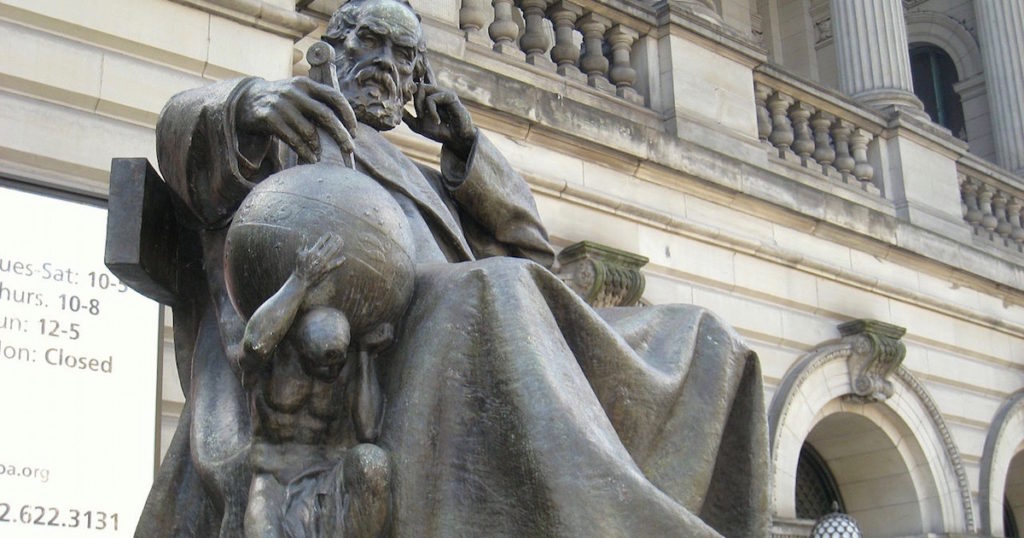 Faith & Science
Faith & Science
 Physical Sciences
Physical Sciences
The Galileo Affair — A Durable Myth

Science writer Katherine Ellen Foley has another article on anthropogenic global warming, or AGW, in Quartz. The AGW theory states that civilization’s production of green-house gases, such as carbon dioxide, is causing a hockey-stick like rise in the Earth’s temperatures.
This has led to a range of dire environmental warnings in recent decades, some of which have already failed. Nonetheless AGW is the consensus theory amongst virtually all climate scientists. How much of this consensus is formed by non-empirical factors — more common in science than is often understood — is an open question. Leaked emails have revealed strong-arm tactics — including pressure on publishers — used to squash dissent. Of course none of this means AGW is necessarily anything less than completely true. But it does compromise unsupported claims that AGW is a strong, empirical theory. Press conferences claiming a case closed won’t cut it — that kind of trust and legitimacy was lost years ago. The guiding light here must be the raw science.
All of this means that AGW appears to be another fascinating example of how science, for better or for worse, works. What I find particularly interesting are high truth claims for ideas that are politically or metaphysically charged and not obviously empirically supported. The problem with science, as Del Ratzsch has pointed out, is that it is done by people. Non-empirical influences are, gasp, sometimes at work and we simply must understand the underlying science rather than blindly accept authoritarian pronouncements.
I am not arguing for or against AGW, but I am arguing for a depth of understanding that too often is missing from partisan accounts. This, unfortunately, characterizes Foley’s Quartz article, which asks the question: What about the research papers questioning AGW? While the vast majority of the literature falls squarely within the AGW-is-true paradigm, there is nonetheless a tiny sliver of papers questioning the theory.
To be sure those papers aren’t having much influence, but according to Foley AGW critics often invoke Galileo as a comparison. Just as Galileo met stiff opposition, so do these AGW dissenters. The implication is that, like Galileo, these researchers will prevail in the end.
Foley explains this is all wrong, both because it is a false analogy and because those papers are scientifically flawed. Specifically, Foley explains that Galileo’s “fellow scientists mostly agreed with his conclusions — it was church leaders who tried to suppress them.” And furthermore, a study of those dissenting papers found them to be biased and faulty.
Foley’s article hit the mark. It has instantly been reposted and retold across the Internet, on blogs, forums, and even videos, such as this one by Jeff Waldorf. Unfortunately Foley’s article is little more than AGW cheerleading, and Waldorf and the others are only too quick to pile on, assigning nefarious motives to anyone who would doubt the consensus theory. It is precisely this kind of hostile, social atmosphere which can be so stifling to science.
Foley’s article is largely a copy and paste job from other sources, and she employs the usual rhetorical devices, such as labelling her targets as “climate-change-denying papers.” Of course they are no such thing. The papers are questioning AGW, not “denying” climate change. This sort of rhetoric, targeted at reasonable skepticism, is a sign of fake news.
The next problem is with her retelling of the Galileo Affair which is all Warfare Thesis. No it wasn’t science versus religion — that is the myth that Foley is propagating. Galileo did not heroically lead a scientific consensus with powerful and unambiguous empirical evidence against ecclesiastical resistance. Church leaders did not “tr[y] to suppress them.”
Nonetheless this gets picked up and amplified by Waldorf and the others, and historians now have yet another round of Galileo mythology to reckon with. The Galileo myth serves as yet another non-empirical mandate for ideas like AGW and evolution, and that is why it is so resistant and durable.
As if to support her Galileo claims, Foley links to a 2011 phony New York Times article by Henry Fountain who provides this absurd retelling of the myth:
Galileo, whose astronomical observations confirmed the Copernican theory that the Earth revolved around the Sun, was basing his assertions on empirical knowledge and faced opposition from the Roman Catholic Church, which supported the Ptolemaic view of an Earth-centered universe.
Of course Galileo’s observations did not “confirm the Copernican theory.” Nor were his “assertions based on empirical knowledge.” Galileo flatly ignored Kepler’s finding that ellipses perfectly described the planetary orbits (as opposed to the lousy circles Galileo advocated which required epicycles). And the lack of stellar parallax observed in the 17th century seemingly contradicted Galileo’s heliocentrism. Furthermore, Galileo studiously avoided mentioning Tycho Brahe’s hybrid model which, again, appeared at the time to compete well with heliocentrism. Galileo carefully framed the debate as strictly heliocentrism versus geocentrism.
Nor did Galileo face any kind of unified opposition from the Roman Catholic Church. That is another myth. There were many in the church who had no problem with Galileo pursuing his ideas, and the Pope had been a benefactor of Galileo before, that is, Galileo turned on him.
The Galileo Affair is far more complex and nuanced than these pathetic retellings would have it. As one historian put it, it was Galileo’s religion versus the Church’s science. But that, of course, would not service Foley’s message.
Next, Foley appeals to a 2015 paper — passed off as something of recent importance — arguing that research papers skeptical of AGW are all flawed. That’s curious.
Why does Foley now resurrect a 2015 review of even older AGW skepticism? Foley generously draws upon a 2015 Guardian article to fill in her story.
Could this retelling of an old story have anything to do with more recent research posing serious challenges to AGW? Could this be an attempt to forestall emerging skepticism, and delegitimize research that points to AGW’s on-going problems?
Consider a new study by John Abbot and Jennifer Marohasy that suggests a rather fundamental failure of AGW. The study shows that pre-industrial climate data robustly models 20th-century temperatures. That should not be the case if AGW is true.
If later 19th- and 20th-century greenhouse gas emissions are causing a hockey stick temperature rise, it should not be consistent with the older data. AGW says that the climate has changed.
Now, perhaps Abbot’s and Marohasy’s new research is flawed. Perhaps they have made a mistake, and so AGW is unharmed by their work. But doesn’t that make for a more interesting article in 2017 than rehashing old myths?
Cross-posted at Darwin’s God.


